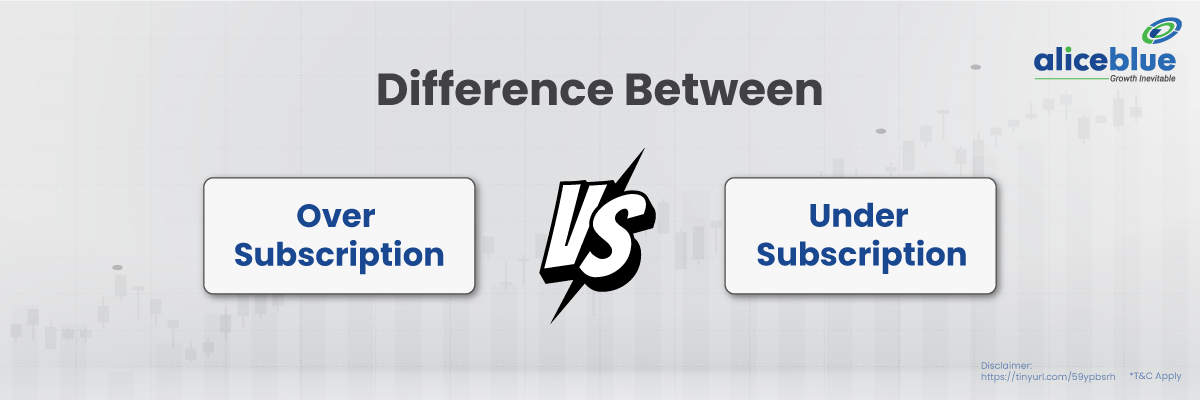The primary difference between over subscription and under subscription is that over subscription refers to a situation where the demand for an offering (such as shares in an IPO) exceeds the total number of shares available. Under Subscription, on the other hand, occurs when the demand is less than the total number of shares available.
Content :
- What Is Under Subscription?
- What Is Over Subscription Of Shares?
- Difference Between Oversubscription And Under Subscription
- Difference Between Over Subscription And Under Subscription – Quick Summary
- Difference Between Over Subscription And Under Subscription – FAQs
What Is Under Subscription?
Under Subscription is when investors do not fully subscribe the total number of shares or securities offered to the market. It indicates a lack of interest or confidence in the offering, often reflecting negatively on the issuer.
Let’s take an example. In 2017, New India Assurance Co Ltd’s IPO witnessed an under-subscription. The IPO was launched with a price band of ₹770-₹800 per share, aiming to raise ₹9,600 crores. However, the retail portion was subscribed only 11% on the first day, and even by the end of the subscription period, it remained under-subscribed.
What Is Over Subscription Of Shares?
Over-subscription of shares happens when the number of shares applied for in an offering (like an IPO) exceeds the total shares available. This is often seen as a positive sign, reflecting strong investor confidence in the company.
To understand this, let’s take an example of the IPO of Reliance Power in 2008, which was oversubscribed 73 times, attracting more than ₹7.5 lakh crores against an issue size of ₹10,123 crores. It was the biggest IPO in India at that time, and the overwhelming response demonstrated the strong belief investors had in the company’s potential and the market’s bullish outlook.
Difference Between Oversubscription And Under Subscription
The primary difference between Oversubscription and Under Subscription is that an oversubscription signifies an excess demand, whereas Under Subscription points to a shortfall in demand.
Other differences can be tabulated as follows:
| Parameters | Oversubscription | Under Subscription |
| Demand Dynamics | Demand exceeds supply, indicating high investor interest in the shares. | Demand is less than supply, reflecting a lack of investor enthusiasm or concerns about the company or pricing. |
| Market Perception | Positive market sentiment and a sign of investor confidence in the company’s prospects. | Negative or lackluster perception, possibly due to unfavorable market conditions or doubts about the business model. |
| Pricing Impact | May lead to higher post-issue pricing, with shares possibly opening at a premium on the stock exchange. | May result in lower post-issue pricing, with shares listing at or below the issue price. |
| Allotment Process | Pro-rata or lottery-based allotment ensures fair distribution among investors when demand exceeds supply. | Full allotment to all subscribers as the shares are not fully subscribed, simplifying the allotment process. |
| Investor Participation | Widespread interest from various categories of investors, including retail and institutional, is often seen. | Limited or selective participation, with fewer investor categories showing interest in the shares. |
| Impact on Issuer | Enhances reputation, potentially leading to positive media coverage and increased brand awareness. | Could damage reputation, raising questions about market readiness or the attractiveness of the business offering. |
| Post-Issue Market Behavior | Potential initial surge in share price post-listing, reflecting strong investor interest and limited supply of shares. | Tepid post-issue market behavior, with limited trading volume and minimal price movement, mirroring the limited investor interest during the subscription period. |
We hope that you are clear about the topic. But there is more to learn and explore when it comes to the stock market, commodity and hence we bring you the important topics and areas that you should know:
| Nrml vs mis |
| Benchmark index meaning |
| What is brokerage in stock market |
| Stock market participants |
| Foreign institutional investors |
| What is right issue of shares |
| holding period |
| what is multibagger stocks |
Difference Between Over Subscription And Under Subscription – Quick Summary
- Over Subscription is when demand exceeds supply, while Under Subscription is when demand falls short of supply.
- The main difference between Over Subscription And Under Subscription is that Oversubscribed IPOs have more buyers than available shares, while undersubscribed IPOs have fewer buyers than shares on offer.
- If you don’t have a Demat account, open with Alice Blue. You can invest in stocks, mutual funds, & IPOs completely free of cost. We provide a Margin Trade Funding facility, where you can use 4x margin to buy stocks, i.e., you can buy stocks worth ₹ 10000 at just ₹ 2500.
Difference Between Over Subscription And Under Subscription – FAQs
What is the Difference Between Over Subscription And Under Subscription?
The primary difference between Over Subscription and Under Subscription lies in demand. Over Subscription means the demand for shares exceeds the available supply, while Under Subscription means the demand is less than the available supply.
How can shares be allotted under subscription?
In the case of over subscription, shares can be allotted through various methods such as pro-rata allotment or a lottery-based system. Pro-rata allotment means the shares are distributed in proportion to the number applied for by each investor. If the over subscription is significantly high, a lottery system may be employed, where allotments are made randomly to ensure fairness.
Is Oversubscription Good For IPO?
Oversubscription is generally considered good for an IPO as it indicates strong investor interest and confidence in the company. It often leads to an initial surge in share price post-listing and can enhance the company’s reputation. However, excessive oversubscription may also create high expectations that could be challenging to meet, leading to volatility in the share price.
Is pro-rata allotment under subscription?
Pro-rata allotment is not usually associated with under subscription but rather with over subscription. Under subscription means there is enough supply for all interested investors, so shares can be fully allotted to all subscribers. In the case of over subscription, pro-rata allotment ensures that shares are distributed proportionally to the number applied for by each investor.
Will I get an IPO if oversubscribed?
If an IPO is oversubscribed, meaning more people want shares than what’s available, there’s no guarantee you’ll get all the shares you applied for. The company might use a pro-rata system to give you some shares, or a lottery system that leaves it up to chance. Sometimes, certain types of investors get priority. So, it’s a bit of a roll of the dice.
To understand the topic and get more information, please read the related stock market articles below.






